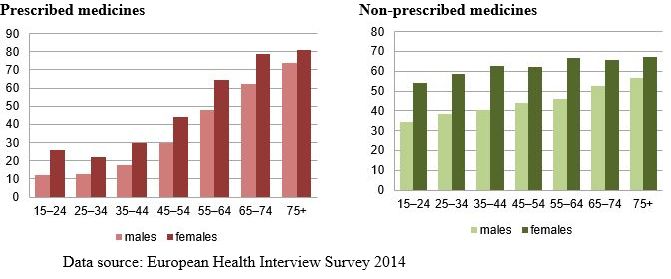Analytics, EU – Baltic States, Health, Latvia, Markets and Companies, Society
International Internet Magazine. Baltic States news & analytics
Saturday, 27.04.2024, 04:29
Non-prescribed medicines are used by 54% Latvian population
 Print version
Print version
Analysis of the data in various socio-economic breakdowns shows the smallest number of persons using prescribed medicines in Zemgale region (37.7%), in richest households (29.8%, 5th (top) quintile), among unemployed (27.1%), and among people with highest education (38.8%). Whereas the highest number of non-prescribed medicines users may be observed in Kurzeme region (44.4%), among population with low level of education (49.2%), among inactive population (61.8%), as well as among persons with higher Body Mass Index (62.4%).
Non-prescribed medicines more often are used by females
Habits of using medicines differ notably between genders. In 2014, prescribed medicines were used by the half of females (49.9%) and almost one third of males (30.7%), whereas non-prescribed medicines – by 43% of males and 62.7% of females. As age of the person increases, the share of both females and males using medicines is growing sharply. Consumption of non-prescribed medicines among females is equally high in all age groups, while among males the indicator grows steadily. For example, in 2014 non-prescribed medicines were used by 34.5% of males aged 15–24 and by 56.6% of males aged over 75.
 |
| Use of medicines among Latvia population, by gender (%) |
Consumption of medicines increases with age – consumption of non-prescribed medicines grows 1.4 times and of prescribed medicines – 4 times
Consumption of non-prescribed medicines rises with age. In 2014, non-prescribed medicines were used by 44.2% of young people aged 15–24 and by 64.4% of elderly people aged over 74. However, consumption of prescribed medicines tends to increase more rapidly – ageing makes to consume 1.4 times more non-prescribed medicines and 4 times more prescribed medicines. The share of young people (aged 15–24) using non-prescribed medicines accounts for 44.2%, while the share of ones using prescribed medicines is much smaller – 19.1%. Compared to 2008, the most notable growth in the consumption on non-prescribed medicines was recorded among population aged over 64 (more than 17%), as well as among females aged 25–34 (17.6%).
Prescribed medicines were used by 73.1% of population aged 65–74, and even more by elderly people aged over 74 – 79.1%. Young people aged 15–24 more often are using prescribed medicines than people aged 25–34 (19.1% and 17.2%, respectively), since females aged 15–24 are using twice as many prescribed medicines as males at the same age (12.3 and 25.9 percentage points, respectively).
Data on use of medicines by Latvia population in 2014 were acquired within the framework of the European Health Interview Survey (EHIS). The survey covered 7 thousand persons aged over 15.
The survey aims at acquiring information on European Union (EU) population self-perceived health status, lifestyles, use and availability of health care services in relation to socio-economic indicators of the population. EHIS was conducted in all EU Member States, as well as in Iceland and Norway. The results acquired within the survey will be used for socio-economic policy planning in each Member State separately and EU as a whole.








 «The Baltic Course» Is Sold and Stays in Business!
«The Baltic Course» Is Sold and Stays in Business!

